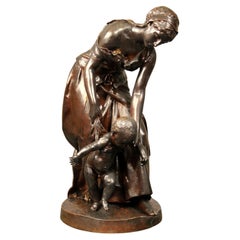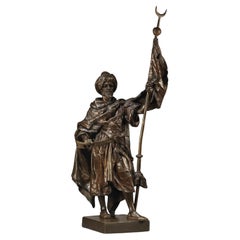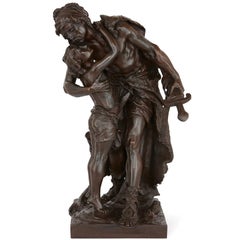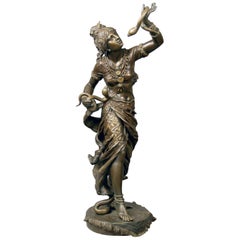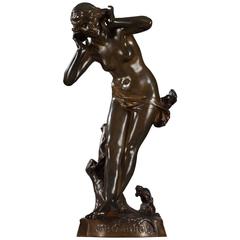Henri Honoré Plé Figurative Sculptures
to
1
3
3
3
3
2
1
3
3
Height
to
Width
to
3
3
3
2
154
150
140
112
Creator: Henri Honoré Plé
A Late 19th Century Bronze Sculpture Entitled “Les Premiers Pas” by Henri Plé
By Henri Honoré Plé, F. Barbedienne Foundry
Located in Long Island City, NY
A Nice Late 19th Century Bronze Sculpture Entitled “Les Premiers Pas” (First Steps) by Henri Plé
Henri Plé and Ferdinand Barbedienne
Depicting a mother helping her baby learn how t...
Category
Late 19th Century French Belle Époque Antique Henri Honoré Plé Figurative Sculptures
Materials
Bronze
Large Multi-Patinated Bronze Figure of an Arab Warrior by Henri-Honoré Plé
By Henri Honoré Plé
Located in Brighton, West Sussex
A Large and Important Multi-Patinated Bronze Figure of an Arab Warrior by Henri Honoré Plé.
Signed Henri Plé to the base.
The figure is finely modelled as an Arab warrior, with sw...
Category
19th Century French Antique Henri Honoré Plé Figurative Sculptures
Materials
Bronze
Antique patinated bronze sculpture of a father and son embracing by Henri Plé
By Henri Honoré Plé
Located in London, GB
This beautiful antique French sculpture depicts a tender moment between father and son. Made of fine patinated bronze, the full length figures of father and son are crafted in the naturalistic style that is typical of Plé's work. The father is dressed in furs and leans to embrace his son in an emotional and touching manner, before he heads to battle. The two figures are set on a naturalistic square plinth, which is signed 'Henri Ple...
Category
Late 19th Century French Classical Greek Antique Henri Honoré Plé Figurative Sculptures
Materials
Bronze
$10,429 Sale Price
20% Off
Related Items
Rare French Orientalist Bronze Sculpture Arab Warrior after Jean Didier Debut
By Jean Didier Debut
Located in Shippensburg, PA
JEAN-DIDIER DEBUT
French, 1824-1893
French Orientalist Model of a Janissaire Warrior
Polychromed and patinated bronze signed "E. Debut", sealed with editeur cachet "Bronze Ga...
Category
20th Century French Henri Honoré Plé Figurative Sculptures
Materials
Bronze
$1,200
H 15.88 in W 4.5 in D 4.5 in
Finely-Modeled Vintage Patinated Bronze Figure of a Golfer
Located in San Francisco, CA
Dressed in vintage 1940s clothes, the pensive golfer stares down the fairway after completing the perfect swing; inscribed EG.
Category
1940s American Other Vintage Henri Honoré Plé Figurative Sculptures
Materials
Bronze
$2,040 Sale Price
20% Off
H 20.5 in W 7 in D 6 in
Large Bronze Patinated Abstract Sculpture "Embracing Couple" by Edit Brodkin
Located in Montreal, QC
Bronze patinated sculpture of embracing couple by Edit Brodkin resting on black granite base. Signed dated and numbered in the back: ''Brodkin 1986 1/3 1986 Dimensions of the sculptu...
Category
1980s Canadian Vintage Henri Honoré Plé Figurative Sculptures
Materials
Bronze
$18,500
H 60 in W 23.25 in D 18 in
Mid 19th Century Animalier Bronze Sculpture entitled "Jiji" by P J Mêne
By Pierre Jules Mêne
Located in London, GB
Delightful mid 19th Century French Animaliers bronze study of a playful Whippet looking around in an attitude to play with a ball at her feet, with rich brown rubbed to a golden colo...
Category
Mid-19th Century French Art Nouveau Antique Henri Honoré Plé Figurative Sculptures
Materials
Bronze
$3,087
H 5.91 in W 6.7 in D 5.91 in
Man and Woman Embraced Patinated Bronze Sculpture by Itzik Ben Shalom
By Itzik Ben Shalom
Located in San Diego, CA
Man and woman embraced patinated bronze sculpture on a black wood base in by listed Israeli artist Itzik Ben Shalom, circa 1980s. The piece is in good vintage condition with some spo...
Category
20th Century Israeli Mid-Century Modern Henri Honoré Plé Figurative Sculptures
Materials
Bronze
$1,440 Sale Price
20% Off
H 10 in W 4 in D 3 in
Patinated Bronze Sculpture/Figure of a Frog
Located in Guaynabo, PR
This is a patinated bronze medium size sculpture of a sitting frog with its right hand in the chest (it’s heart). This gesture symbolizes dignity and hono...
Category
20th Century Unknown Modern Henri Honoré Plé Figurative Sculptures
Materials
Bronze
19th Century Bronze Sculpture Father And Son By Henri Honore Plé
By H. Ple
Located in Norwood, NJ
Henri Honore Plé (1853 - 1922). This beautiful original 19th century French sculpture depicts a moment between father and son. Fine quality patinated bronze, in the naturalistic styl...
Category
Late 19th Century French Beaux Arts Antique Henri Honoré Plé Figurative Sculptures
Materials
Bronze
Patinated Bronze Sculpture of a Youth, Italy
Located in Washington, DC
Patinated Bronze Sculpture of a Youth, Italy, circa 20th century. Bronze Replica of "Ombra della sera / Shadow of the evening" Etruscan bronze, 3rd century BC, Museo Etrusco Guernacc...
Category
20th Century Henri Honoré Plé Figurative Sculptures
Materials
Bronze
Bronze Sculpture, Late 19th Century, Asia
Located in Saint-Ouen, FR
Bronze sculpture, late 19th century, Asia
Measures: H 19cm, W 15cm, W 8cm.
Category
1880s Asian Chinese Export Antique Henri Honoré Plé Figurative Sculptures
Materials
Bronze
20th Cenrury Patinated Bronze Figure of a Lion
Located in Germantown, MD
A 20th Cenrury neoclassical Patinated Bronze Figure of a Lion
Measures 18" in width x 4.5" in depth x 10.5" in height.
Category
Mid-20th Century American Neoclassical Henri Honoré Plé Figurative Sculptures
Materials
Bronze
E Picault, Victoria, Bronze Sculpture, Late 19th Century
By Émile Louis Picault
Located in MARSEILLE, FR
Victoria: bronze sculpture with a brown patina of a victorious warrior, on a red marble base
This bronze is entitled "Victoria" and is signed by the artist Emile Picault
Emile Pica...
Category
19th Century French Napoleon III Antique Henri Honoré Plé Figurative Sculptures
Materials
Marble, Bronze
Late 19th Century Art Nouveau Sculpture "Venus de Milo" by F. Barbedienne
By F. Barbedienne Foundry
Located in London, GB
A large and impressive late 19th Century bronze study of the famous Venus de Milo sculpture of antiquity with excellent rich brown patina and good hand finished surface detail, inscribed F.Barbedienne foundry
ADDITIONAL INFORMATION
Height: 95 cm
Width: 28 cm
Depth: 28 cm
Condition: Excellent Original Condition
Circa: 1890
Materials: Bronze
Foundry: F.Barbedienne
SKU: 7741
ABOUT
The Barbedienne Foundry is a famous 19th century bronze foundry, whose statues and art objects became rapidly very renowned. This bronze studio co-worked with other trades, and put his name to a great variety of works, such as furnishing in particular. Attending every World's Fair of its time, the Barbedienne Foundry was regularly awarded, notably at the World's Fair of 1855 where it was awarded the Great Medal of Honor.
A Parisian bronze maker and caster, Ferdinand Barbedienne (1810-1892) creates a firm in 1839 in collaboration with Achille Collas, the inventor of the mechanical method to obtain copies of sculptures at a smaller scale. With this groundbreaking proceed, they facilitated an unprecedented production. Under the “Collas et Barbedienne” name, they specialized in Antiquity copies and perfected new chemical methods for the color and patina finish of their bronzes. As a true Romantic, Ferdinand Barbedienne is committed to democratization of arts, he thus realizes numerous Antiquity copies and stimulates his contemporaries’ works broadcasting. A great deal of famous sculptures are hence cast by the Barbedienne Foundry. All his life, Barbedienne co-worked with the greatest artists, sculptors or designers of his time, such as Edouard Lievre, Ferdinand Levillain, Attarge, Aizelin, Barye or Fremiet.
Statues aside, he products a great deal of decorative artifacts, such as clocks, vases, mirrors, etc. Since 1855, Ferdinand Barbedienne collaborates with the famous decoration designer Louis-Constant Sévin (1821-1888). Joining the firm as a sculptor-designer, he stays loyal to it his life long, always finding more new designs for daily objects, which hence become true art works. Sevin’s creations, specialized in the “Neo-Greek” style, were particularly appreciated for antiquity reference in decorative arts, just like the great mirror preserved by the Orsay Museum. He also teams up with enamelers including Alfred Serre, and develops a set of “cloisonnés” enamels that made the headlines at the World's Fair of 1862 in London, which was the very beginning of the art of enamel’s return. In collaboration with Serre, Barbedienne realized between 1878 and 1889 the Monumental Clock in Renaissance style, decorated with enamels, which is preserved in the Paris City Hall.
Venus de Milo
Facts about Venus de Milo sculpture.
For much of the world, the mystery of the Venus de Milo lies in her missing arms. But there’s much more to this iconic statue than a couple of absent appendages.
1. Venus de Milo‘s title is a bit misleading.
It’s popularly believed that this Grecian statue depicts the Greek Goddess of love and beauty, who was often rendered half-naked. However, the Greeks would have called this deity Aphrodite. Nonetheless, the Roman-inspired Venus de Milo caught on.
2. She’s named in part for where she was discovered.
On April 8, 1820, a farmer named Yorgos Kentrotas came across the statue in pieces within the ruins of an ancient city on the island of Milos (formerly known as Melos).
3. Alexandros of Antioch is credited with her creation.
A sculptor of the Hellenistic period, Alexandros is believed to have carved this masterpiece between 130 and 100 BCE. The inscription on the plinth—the slab on which the statue rested—that identified him as Venus de Milo‘s creator was lost nearly 200 years ago.
4. She might not be Venus.
Some have suggested the sculpture is not Aphrodite/Venus, but Amphitrite, the sea goddess who was particularly adored on Milos. Still others have proposed she’s Victory, or perhaps a prostitute. With her arms long missing, would-be context clues have been lost for centuries. A spear could have meant one thing, a spool of thread another. If she held an apple—as some reports claim—it could mean she was Aphrodite, holding the award given to her by Paris before the Trojan War began. To this day, it’s a matter of passionate debate.
5. She became a gift to the King of France.
When Kentrotas called upon a French naval officer to help him unearth the spectacular sculpture, he began a chain of events that would eventually lead to the Marquis de Rivière presenting Venus de Milo to Louis XVIII. In turn, the ruler gave the statue to the Louvre, where it is on display to this very day.
6. The loss of her limbs is the fault of the French.
Kentrotas did find fragments of an arm and a hand when he uncovered the statue in the ruins, but as Venus de Milo was being reassembled, those arms were discarded for having a “rougher” appearance. Modern art historians believe that the variation of finish does not mean those arms did not belong to Venus, but both the arms and the original plinth have been lost since the piece moved to Paris in 1820.
7. The original plinth was ditched on purpose.
Sight unseen, early 19th century art historians decided the newly discovered Venus must have been the work of Greek artist Praxiteles, and publicized the work as such. This attribution would have placed the piece in the Classical period (5th through 4th centuries BCE), which was more respected artistically than the Hellenistic period. To save face and better promote Venus de Milo—even at the cost of misinforming the public—the plinth was removed before it was presented to the King.
8. Venus de Milo was meant to make up for a national embarrassment.
During his conquests, Napoleon Bonaparte had plundered one of the finest examples of Greek sculpture, Venus de’ Medici, from Italy. In 1815, the French government returned that beloved sculpture, but in 1820, France embraced the chance to fill the hole its absence left in the French culture and national pride. As such, Venus de Milo was promoted as being even greater than Venus de’ Medici upon her Louvre debut. The ploy worked, and the piece was met with almost universal praise from artists and critics.
9. Renoir was not impressed.
Perhaps the most famous of Venus de Milo‘s detractors, the celebrated Impressionist painter dismissed this delicate depiction of grace and female beauty as “a big gendarme.”
10. She went into hiding during World War II.
By the autumn of 1939, war threatened to descend on Paris, so Venus de Milo along with some other priceless pieces, such as Winged Victory of Samothrace and Michelangelo’s Slaves, were whisked away for safekeeping at various châteaux in the French countryside.
11. She’s been robbed!
Venus is missing more than just her arms. She was originally draped in jewellery including a bracelet, earrings and a headband. These flourishes are long lost, but the holes for fixing them to the piece remain in the marble, giving clues to the missing accessories.
12. She lost her colour.
While it’s easy for today’s art admirers to think of Greek statues as white, the marble was often painted in the style of polychromy. However, no trace of the original paint scheme remains on Venus de Milo today.
13. She’s taller than most people.
Even with her slight slouch, Venus de Milo stands at 6 feet 8 inches tall.
14. She could be a copy.
Art historians have noted that Venus de Milo bears a striking resemblance to Aphrodite of Capua, which is a Roman era copy of a possibly late 4th century BCE bronze Greek original. That would be at least 170 years before Alexandros carved his goddess, leading some to speculate that both statues are actually replicas of an older statue...
Category
Late 19th Century French Art Nouveau Antique Henri Honoré Plé Figurative Sculptures
Materials
Bronze
$12,007
H 37.41 in W 11.03 in D 11.03 in
Previously Available Items
Fantastic Quality Late 19th Century Bronze Sculpture of Cleopatra by Henri Plé
By Henri Honoré Plé
Located in Long Island City, NY
A fantastic quality late 19th century bronze sculpture of Cleopatra.
Signed Henri Plé.
The subject is based on the popular belief that when Cleopatra c...
Category
Late 19th Century French Belle Époque Antique Henri Honoré Plé Figurative Sculptures
Materials
Bronze
H 38 in W 15 in D 17 in
Large Figural Bronze “L’echo des bois” by Henri Honore Plé
By Henri Honoré Plé
Located in Paris, FR
Late 19th century figural bronze in warm, mid-brown patina. The nude maiden is holding her hands cupped behind her ears and is standing on a naturalistically modeled ground. In relie...
Category
Early 1900s French Art Nouveau Antique Henri Honoré Plé Figurative Sculptures
Materials
Bronze
Henri Honoré Plé figurative sculptures for sale on 1stDibs.
Henri Honoré Plé figurative sculptures are available for sale on 1stDibs. These distinctive items are frequently made of metal and are designed with extraordinary care. There are many options to choose from in our collection of Henri Honoré Plé figurative sculptures, although gold editions of this piece are particularly popular. If you’re looking for additional options, many customers also consider figurative sculptures by Antoine-Louis Barye, and August Moreau. Prices for Henri Honoré Plé figurative sculptures can differ depending upon size, time period and other attributes — on 1stDibs, these items begin at $12,281 and can go as high as $38,000, while a piece like these, on average, fetch $35,343.
